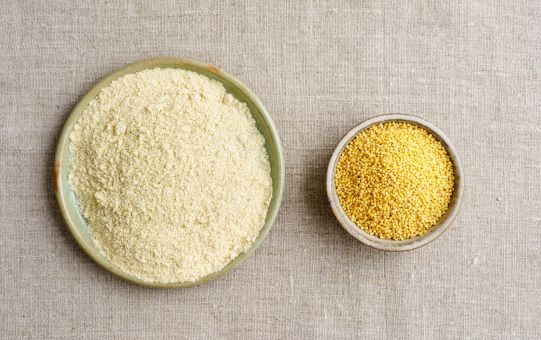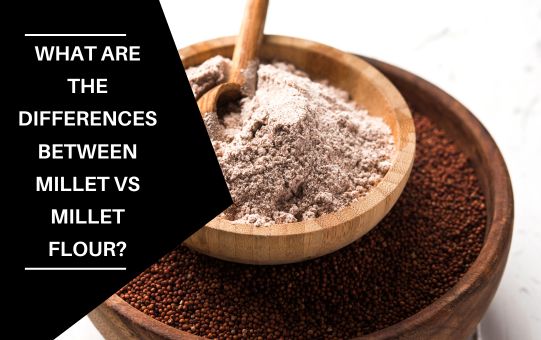When it comes to alternative grains and flour, millet vs millet flour has gained significant attention due to its numerous health benefits and culinary versatility. So, let’s delve into the world of millet vs millet flour!
What are the differences between millet vs millet flour? Millet, in its whole-grain form, refers to a group of small-seeded grasses that have been cultivated for thousands of years. These grains are widely consumed in many parts of the world and are known for their resilience and adaptability to different climates.
On the other hand, millet flour is the result of grinding millet grains into fine powder. This flour serves as a nutritious and gluten-free alternative to traditional wheat flour, making it suitable for individuals with gluten intolerance or those seeking diverse culinary options.
To know more about millet vs millet flour keep reading this interesting article trust me it will definitely enhance your knowledge about millet.
Contents
What is Millet?
Millet, often referred to as a “superfood,” is a gluten-free grain that has been cultivated for thousands of years. It is a staple food in many parts of the world, particularly in Africa and Asia.
Millet is known for its small, round grains that come in various colors, such as yellow, white, and red. These grains can be cooked and used in a wide range of dishes, including porridge, salads, soups, and side dishes.
What is Millet Flour?
Millet flour, on the other hand, is made by grinding millet grains into a fine powder. This flour can be used as a substitute for wheat flour in many recipes, making it an excellent option for individuals with gluten sensitivities or those following a gluten-free diet.
Millet flour has a slightly sweet and nutty flavor, which adds a unique taste to baked goods and other culinary creations.
What is the Differences between Millet vs Millet Flour?
Now that we have a basic understanding of millet and millet flour, let’s dive deeper into the key differences between the two.
1. Form and Texture
Millet is primarily consumed in its whole-grain form, where the grains retain their distinct shape and texture after cooking. The grains are small and round, with a mild and slightly nutty taste.
On the other hand, millet flour has a fine, powdery texture similar to other types of flour, making it ideal for baking purposes.
2. Culinary Uses
Millet can be prepared in various ways. It can be cooked on its own or used as an ingredient in dishes like pilaf, salads, and stews.
Millet flour, on the other hand, is predominantly used in baking to make bread, cakes, cookies, and pancakes. Its unique flavor and texture contribute to the overall taste and consistency of the final product.
3. Gluten Content
One of the significant differences between millet and millet flour is their gluten content. Millet is a naturally gluten-free grain, which makes it suitable for individuals with gluten intolerance or those who follow a gluten-free diet.
Millet flour, obtained from grinding millet grains, retains this gluten-free property, making it a suitable alternative to wheat flour for individuals with celiac disease or gluten sensitivities.

4. Nutritional Composition
Both millet and millet flour offer several nutritional benefits, although there are slight variations between the two. Millet grains are rich in essential nutrients, including dietary fiber, magnesium, phosphorus, and B vitamins.
They are also a good source of antioxidants. Millet flour retains many of these nutrients but may have a slightly different nutrient profile due to the grinding process.
5. Cooking Times
When it comes to cooking times, millet grains and millet flour differ significantly. Millet grains typically take around 15 to 20 minutes to cook, depending on the desired consistency. Millet flour, however, is primarily used in baking recipes, where the cooking time varies based on the specific recipe and oven temperature.
Read Also>>>Which one is considered better millet vs lentils?
How to Use Millet Flour in Cooking?
Using millet flour in cooking requires an understanding of its unique properties. When substituting millet flour for wheat flour in recipes, it is essential to consider the difference in texture and moisture content.
In general, a 1:1 substitution ratio is not recommended. Instead, a combination of millet flour and other gluten-free flour like rice flour or almond flour often yields better results.
You can adjust the recipe to achieve the desired consistency are key to successful baking with millet flour.

Conclusion
Millet and millet flour share a close relationship, yet they have distinct characteristics that set them apart. Millet, with its small, round grains, offers a versatile ingredient for various dishes, while millet flour provides a gluten-free alternative for baking.
Understanding the differences between these two forms allows you to make informed decisions about their usage in your cooking endeavors. So whether you’re preparing a hearty pilaf or baking a delicious gluten-free cake, millet and millet flour are fantastic additions to your culinary repertoire.
Read Also>>>WHICH IS BETTER Millet or WHEAT FLOUR
FAQs about Millet vs Millet Flour
Here are some frequently asked questions about the differences between millet and millet flour:
Can Millet Flour Be Used As A Substitute For All-Purpose Flour?
Yes, millet flour can be used as a substitute for all-purpose flour in many recipes. However, due to its gluten-free nature, it may require additional binding agents or a combination of other gluten-free flours to achieve similar results.
Does millet flour have the same nutritional benefits as millet grains?
Millet flour retains many of the nutritional benefits of millet grains, including dietary fiber and essential nutrients. However, the grinding process may lead to slight variations in the overall nutrient composition.
Are millet and millet flour suitable for individuals with gluten intolerance?
Yes, both millet and millet flour are gluten-free and can be safely consumed by individuals with gluten intolerance or celiac disease.
Can millet flour be used for thickening sauces or soups?
While millet flour can be used for thickening purposes, its fine texture may result in clumping. It is recommended to mix millet flour with a small amount of liquid before adding it to sauces or soups to prevent lumps from forming.
How should millet and millet flour be stored?
Both millet and millet flour should be stored in airtight containers in a cool, dry place. This helps to maintain their freshness and prevent the infestation of insects or moisture absorption.

